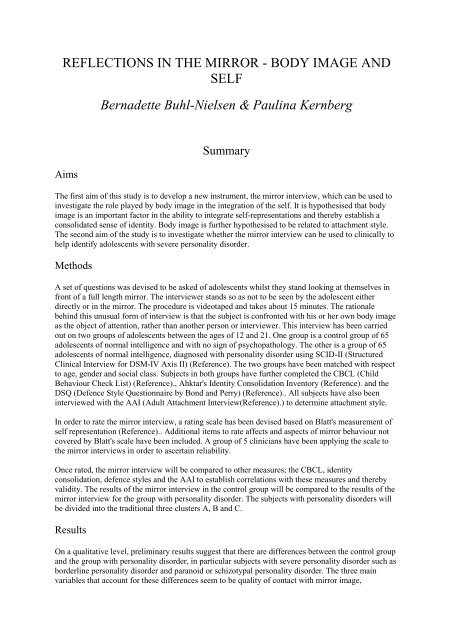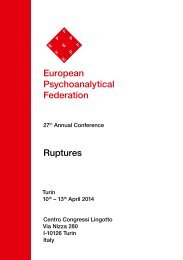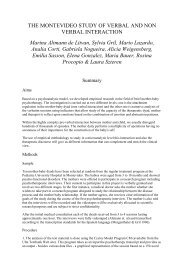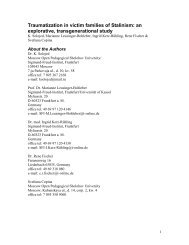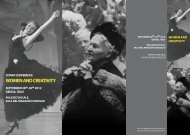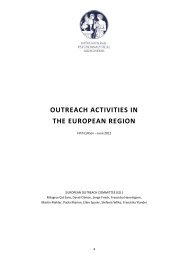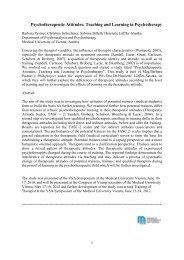Bernadette Buhl-Nielsen & Paulina Kernberg - International ...
Bernadette Buhl-Nielsen & Paulina Kernberg - International ...
Bernadette Buhl-Nielsen & Paulina Kernberg - International ...
You also want an ePaper? Increase the reach of your titles
YUMPU automatically turns print PDFs into web optimized ePapers that Google loves.
REFLECTIONS IN THE MIRROR - BODY IMAGE AND<br />
SELF<br />
Aims<br />
<strong>Bernadette</strong> <strong>Buhl</strong>-<strong>Nielsen</strong> & <strong>Paulina</strong> <strong>Kernberg</strong><br />
Summary<br />
The first aim of this study is to develop a new instrument, the mirror interview, which can be used to<br />
investigate the role played by body image in the integration of the self. It is hypothesised that body<br />
image is an important factor in the ability to integrate self-representations and thereby establish a<br />
consolidated sense of identity. Body image is further hypothesised to be related to attachment style.<br />
The second aim of the study is to investigate whether the mirror interview can be used to clinically to<br />
help identify adolescents with severe personality disorder.<br />
Methods<br />
A set of questions was devised to be asked of adolescents whilst they stand looking at themselves in<br />
front of a full length mirror. The interviewer stands so as not to be seen by the adolescent either<br />
directly or in the mirror. The procedure is videotaped and takes about 15 minutes. The rationale<br />
behind this unusual form of interview is that the subject is confronted with his or her own body image<br />
as the object of attention, rather than another person or interviewer. This interview has been carried<br />
out on two groups of adolescents between the ages of 12 and 21. One group is a control group of 65<br />
adolescents of normal intelligence and with no sign of psychopathology. The other is a group of 65<br />
adolescents of normal intelligence, diagnosed with personality disorder using SCID-II (Structured<br />
Clinical Interview for DSM-IV Axis II) (Reference). The two groups have been matched with respect<br />
to age, gender and social class. Subjects in both groups have further completed the CBCL (Child<br />
Behaviour Check List) (Reference)., Ahktar's Identity Consolidation Inventory (Reference). and the<br />
DSQ (Defence Style Questionnaire by Bond and Perry) (Reference).. All subjects have also been<br />
interviewed with the AAI (Adult Attachment Interview(Reference).) to determine attachment style.<br />
In order to rate the mirror interview, a rating scale has been devised based on Blatt's measurement of<br />
self representation (Reference).. Additional items to rate affects and aspects of mirror behaviour not<br />
covered by Blatt's scale have been included. A group of 5 clinicians have been applying the scale to<br />
the mirror interviews in order to ascertain reliability.<br />
Once rated, the mirror interview will be compared to other measures; the CBCL, identity<br />
consolidation, defence styles and the AAI to establish correlations with these measures and thereby<br />
validity. The results of the mirror interview in the control group will be compared to the results of the<br />
mirror interview for the group with personality disorder. The subjects with personality disorders will<br />
be divided into the traditional three clusters A, B and C.<br />
Results<br />
On a qualitative level, preliminary results suggest that there are differences between the control group<br />
and the group with personality disorder, in particular subjects with severe personality disorder such as<br />
borderline personality disorder and paranoid or schizotypal personality disorder. The three main<br />
variables that account for these differences seem to be quality of contact with mirror image,
differences between self as felt and self as seen and effect of the interview on the viewer. The quality<br />
of contact with the mirror image can be seen in the type of eye contact that the subject has with their<br />
mirror image and the presence of warm, positive affect expressed during the interview. In control<br />
subjects, eye contact consists in a reasonable amount of direct eye contact. Breaks in eye contact<br />
consist in the subject looking away for brief periods of time but establishing direct eye contact again<br />
after the break. Warm positive affect is seen partly by what is said but most importantly by a relaxed<br />
harmonious stance with the subject smiling at him or herself and deriving pleasure from the mirror<br />
image. In subjects with severe personality disorder eye contact is either wandering or staring and<br />
transfixed. These subjects are also characterised by very little show of positive affect towards the<br />
mirror image.<br />
In the control group there seems to be a smooth relationship between self as seen and self as felt. In<br />
the group with severe personality disorder this relationship breaks down and subjects find the sight of<br />
themselves alienating and painful, sometimes to the extent of feeling that it is someone else or a dead<br />
person they are looking at. The inability to co-ordinate self as seen with self as felt seems to be a<br />
feature of psychopathology that is easily elicited by the mirror interview.<br />
The effect of the interview on the viewer tends to be more intense than in traditional interviews and is<br />
perhaps due to the fact that the viewer of the videotape experiences is being watched by the subject as<br />
if the viewer were in fact the subject. In cases where the subject expresses strong negative affects<br />
towards the mirror image, this is disconcerting.<br />
On a quantitative level, these findings have been operationalised and included in the rating scale.<br />
They are currently being tested for reliability and validity.<br />
References<br />
[to be added]<br />
Implications for psychoanalysis<br />
The significance of this research project lies partly in an advance in method. The mirror interview is<br />
unique in being an interview in which the subject relates mainly to him or herself and not to an<br />
interviewer. The mirror interview is also unique in that it is an interview in which the subject is very<br />
much confronted with his or her body image whilst being asked questions of a psychological nature.<br />
This challenge reveals the extent to which the body self is integrated with image of the self as a<br />
whole. The mirror interview also sheds light on the way in which the subject is able to regulate affects<br />
non-verbally whilst verbally producing a narrative. A lack of harmony between these two aspects of<br />
regulation seems to characterise the interviews of subjects with personality disorder. Whilst watching<br />
the mirror interview, the viewer has a double position, he or she watches the interview, but is at the<br />
same time being watched by the subject. In a normal interview one is watched by the subject, as the<br />
subject sees an object in other words the interviewer. It is a central tenet of psychoanalysis that the<br />
subject will project him or herself onto the object, to a greater or lesser degree. In the mirror<br />
interview, the viewer is watched not as an object, but as the subject. In watching the interview the<br />
viewer takes the place of the mirror image and the eyes of the subject rest on the viewer, as if the<br />
viewer were the subject. The full impact of how the subject feels about him or herself is brought to<br />
bear on the viewer. In subjects with personality disorder, these projective mechanisms are magnified<br />
as the full force of the subject's negative affects and disgust about him or herself are experienced<br />
directly by the viewer.<br />
The mirror interview is significant in the advance in knowledge in that it seems that an important<br />
aspect of an integrated self representation is the ability to integrate self as seen with self as felt.<br />
Subjects with personality disorder reveal during the mirror interview how they feel their self image is<br />
split; they have difficulty relating how they feel with how they look. This split or lack of co-
ordination between self as seen and self as felt is understandable in the light of infant research in<br />
particular the role of parental mirroring. Research shows how the infant receives and must co-ordinate<br />
two different sets of data. Data from the body in the form of internal bodily signals and sensory data<br />
from the outside world in the form of sight, sound, touch etc. In subjects with personality disorder<br />
these two sets of data do not seem to be integrated and this becomes apparent during the mirror<br />
interview.<br />
Keywords<br />
Adolescents, body image, personality disorder, mirror, self<br />
Bibliography<br />
<strong>Buhl</strong>-<strong>Nielsen</strong>, B. (2003). Has the baby been given back? Mirror behaviour in adolescents. Paper<br />
presented at the The Second New Style EPF Annual Conference, Sorrento, April.<br />
<strong>Buhl</strong>-<strong>Nielsen</strong>, B. (2004). Affect Regulation and Self Image as seen in Mirror Behaviour. Paper<br />
presented at the XIX Nordic Psychoanalytic Congress, Copenhagen, August.<br />
<strong>Kernberg</strong>, P., & <strong>Buhl</strong>-<strong>Nielsen</strong>, B. (2004). Mirrors, Body image and Self. Paper presented at the 6th<br />
Delphi <strong>International</strong> Psychoanalytic Symposium, Delphi, October.


